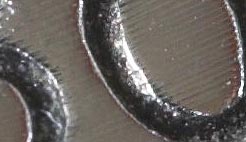Sigma 105mm f/2.8 EX DG Macro
This true Macro lens from Sigma already had an enviable reputation prior to its DG upgrade for the digital revolution. The non-DG version was one of the first lenses I purchased for my first dSLR and is still in use. Here, we take a look at the newer version and see whether the DG is marketing hype or a genuine advance.
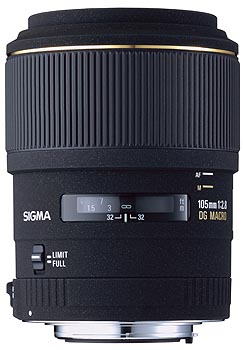 Specifications
Specifications
- Focal Length 105mm
- Aperture f/2.8
- Construction 11/10 elements/groups
- Closest focus 0.312m (1:1)
- Aperture blades 8
- Filter size 58mm
- Weight 0.45kg
- Dimensions 74x95mm
- Hood Screw in (supplied)
- Mounts Sigma, Canon, Nikon, Pentax, K-M
- Price (SRP) £339.99
Build and handling
Supplied in a padded zip pouch with belt loop and, in the UK, a three-year warranty, the lens has a solid feel to it. Being a prime lens it is very simple with just an AF/MF switch where appropriate and a focus limit switch working each side of 0.39-0.4m to help out the AF speed.
Autofocus on macro lenses is notoriously slow but this one is useable under normal circumstances and although not silent, it is not so loud as to be annoying. To help in this area, the manual focus ring is disengaged by a very positive pull/click backwards on the ring, allowing the AF to operate without turning the manual ring. Focussing does extend the inner barrel, a solid single trombone, by as much as 51mm at 1:1, but the majority of this travel is for distances below 1m.
The front element does not rotate during the focussing operation, making the use of grad and polarising filters quite simple on the 58mm thread. The supplied hood, now in engineering plastic with a metal thread, screws into the filter thread, but carries a secondary thread of its own, this time at the popular 77mm size. So if you already have filters for a wide lens at 77mm, there is no need to purchase extra filters. The only disadvantage of this system is the inability to fit the lens cap whilst the hood is fitted. Markings on the extending part of the barrel, in white for AF and gold for MF give an indication of the reproduction ratio you are achieving. There is also a distance window, with a nominal DOF scale, neatly rebated into the body of the lens.
The lens balances well on most modern dSLR’s and is not so heavy that it won’t sit on a strap around the neck all day. The focal length is sufficient that you don’t have to get too close to the subject to fill the frame with targets like butterflies, insects, flowers and the like. This helps avoid getting shadows in the way.
Optical quality
The resolution figures come straight in at good when wide open and by f/5.6 are very good, staying there until well past f/11 before starting the decline into reciprocity. Contrast, which is good on the older, non-DG models, is better again on this new DG version. The coatings used to reduce incidences of flare and ghosting caused by reflections off shiny digital sensor surfaces have the added advantage that they have improved contrast considerably on all the lenses that they have been applied to. Contrast goes a long way in helping perceived definition.
Other aberrations, such as CA are well controlled, never reaching a level of more than 0.5 of a pixel where a threshold of one pixel is the point where they start to become visible.. Distortion, as could be expected on a prime lens of this nature, is undetectable to the eye and measured a negligible 0.25% pincushion across the full width of the frame.
 Shot at f/8 on a Canon 20d, this shots shows the general short telephoto versatility of the lens. | 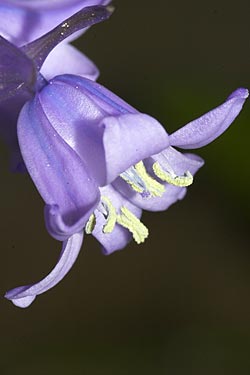 This close-up, at almost 1:1, of a bluebell flower begins to give an idea of the type of detail it is possible to record with this lens. 1/160sec at f/8 with on board flash set at –2 stops firing twin Pentax Slave flashes. Canon 20D |
| 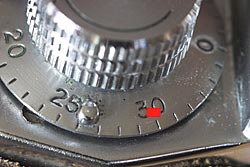 |
Click on each comparision photo below to view full size versions
Below is our lens test data. To find out how to use these graphs look at this article: How we test lenses
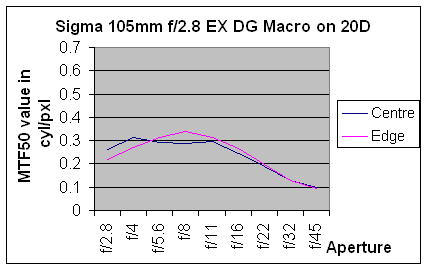
Verdict
A good lens made better. The improvement in contrast and extra control of flare and ghosting provided by the DG coating are, in themselves, worth the upgrade. Improvements have also been made to the hood along with a reduction, albeit slight, in the AF noise. Optical quality cannot really be faulted and with the edges performing as well as the centre on a cropped camera you can expect good edge performance on a full frame body too.
In summary, the positive points of the Sigma EX 105mm f/2.8 Macro DG are:
![]() Very good optical performance throughout the aperture range
Very good optical performance throughout the aperture range
![]() Edges as good as centre. (on APS-C sensor)
Edges as good as centre. (on APS-C sensor)
![]() Contrast and aberration control improved from older model
Contrast and aberration control improved from older model
![]() Value for money
Value for money
The negative points are:
![]() AF still not lightning.
AF still not lightning.
![]() Lens cap not useable with hood. (minor niggle)
Lens cap not useable with hood. (minor niggle)
Check out the latest price for the Sigma EX 105mm f/2.8 Macro DG here
Test by Ian Andrews www.wildaboutkent.com
RR
I use both full-frame and APS-C Canon DSLR's and find the lens performs far better on the cropped APS-C sized sensor where it is using only the central 'sweet-spot' of the image circle. On full-frame, it doesn't have the same advantage and consequently produces much less satisfying results, particularly to the edges and even more so, the extreme corners of the frame.
Even more surprising, I find the 70mm f/2.8 Macro to be a sharper lens on APS-C sized cameras with results that equall and in some cases, better those of the renowned Canon 100mm f/2.8 EF USM Macro. The 105mm f/2.8 Macro on the other hand, doesn't seem to compare well with these two lenses, in my experience.
David Chamberlain
Add your message
Please login here or if you've not registered, you can register here. Registering is safe, quick and free.
photodo Stats
428 MTF tests
74 in-depth photodo reviews
100+ users join each day
Help the lens community by reviewing or rating a lens today via our lens search
Latest Lens Reviews
- Chinon 28mm f/2.8 Vintage Lens Review
- Canon EF 70-200mm f/4L IS II USM Lens Review
- Samyang AF 85mm f/1.4 EF Review
- Sigma 70mm f/2.8 DG Macro Art Review
- Samyang AF 24mm f/2.8 FE Review
- Meike 50mm f/1.7 Review
- Tamron 70-210mm f/4 Di VC USD Review
- Lensbaby Burnside 35mm f/2.8 Review
- Asahi Super Takumar 50mm f/1.4 Review
- Asahi Super-Multi-Coated Takumar 135mm f/3.5 Review
